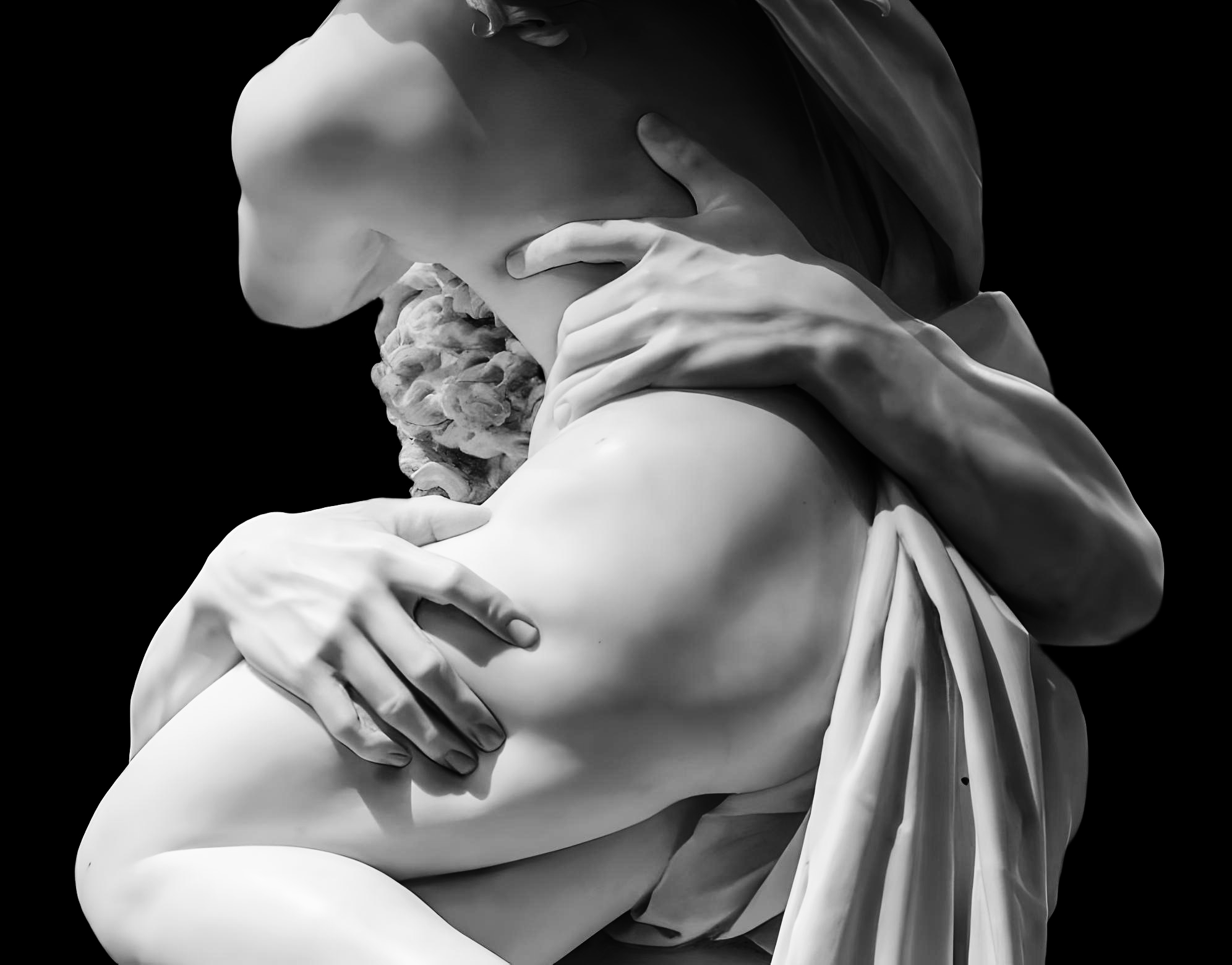Art expresses our lost feelings and has a way of drawing us back to what deeply matters, to the stories and emotions that connect us all. Bernini’s Abduction of Persephone is one of those works that invites us to look closer, to feel the tension and complexity of human struggle etched into marble. It’s not about romanticizing the past—it’s about understanding it, grappling with it, and, in the process, maybe seeing ourselves a little more clearly.
Sometimes we lose contact with our cultural roots as we pursue the transitory or virtue signal to the current fad. Gian Lorenzo Bernini’s Abduction of Persephone, 1621–1622 is a technical masterclass in marble sculpting, capturing a moment of violent motion with an unsettling realism. The force of Pluto’s grip on Persephone, his fingers indenting her flesh, is often admired for its lifelike execution—but this should be understood as a demonstration of artistic skill, not a glorification of the act it depicts.
Classical Context and Technique
Bernini was operating within the Baroque tradition, a shift from the idealized restraint of High Renaissance sculpture to dynamic, almost theatrical compositions. This piece, commissioned by Cardinal Scipione Borghese, follows in the wake of works like Gian Bologna’s The Rape of the Sabine Women (1583), which also explored the theme of violent abduction in a sculptural spiral. However, Bernini’s distinction lies in his ability to manipulate marble into seemingly pliant flesh, a technique not seen in Michelangelo’s robust and muscular forms or Algardi’s more restrained relief work.
Bernini’s skill in creating texture contrast—Pluto’s sinewy grip against the softness of Persephone’s thigh—owes much to his deep understanding of chiaroscuro in sculpture, using light and shadow to enhance depth. His near-contemporary, François Duquesnoy, was experimenting with similar lifelike textures in his Saint Susanna (1629), though with less emphasis on movement.
Narrative and Psychological Weight
Unlike classical Greek works that presented mythological figures with detached grandeur—consider the Hellenistic Laocoön and His Sons—Bernini injects psychological urgency. Persephone resists, her fingers pushing against Pluto’s face, her body twisting to escape. The composition is a frozen struggle, a snapshot of imbalance rather than a resolved tableau.
This moment of intrusion—of interference—unsettles. The piece is not neutral; it is charged with tension. Its admiration should lie in Bernini’s ability to conjure breath from stone, not in the event it represents.
Classical mythology often skirts moral scrutiny in modern readings, but it is important to contextualize such scenes as artistic renderings of power struggles, not endorsements of them. The viewer’s task is to engage with the piece critically, understanding both its technical brilliance and the weight of its subject matter.
Bernini’s ability to create the impression of soft flesh from marble required an advanced understanding of both human anatomy and the properties of stone. Achieving this level of realism involved:
Precision carving: The indentations had to be deep enough to suggest real pressure but subtle enough not to appear unnatural or exaggerated.
Polishing techniques: Bernini used highly refined polishing to create a skin-like smoothness, differentiating Persephone’s delicate flesh from Pluto’s rougher, more muscular form.
Contrast with drapery: The dynamic folds of Persephone’s flowing garments further enhance the contrast between her soft skin and the rigid grip of Pluto’s hands.
Bernini’s Influence on Later Artists
This small but powerful detail—the impression of fingers in flesh—became a hallmark of Bernini’s sculptural style and influenced many later artists. His ability to evoke such realism set a new standard in Baroque art, pushing sculpture beyond the static poses of the Renaissance into the realm of movement and intense emotion.
Many later sculptors and painters would attempt to replicate his tactile realism, but few could match the way Bernini balanced technical skill with psychological depth. His Abduction of Persephone remains one of the most emotionally charged and technically brilliant sculptures in Western art, with those finger impressions standing as a testament to his genius.
Conclusion
The finger impressions in Abduction of Persephone may seem like a minor detail, but they embody everything that makes Bernini’s work so extraordinary. Through his unparalleled skill, he transformed marble into something that feels real, visceral, and deeply human. These small indentations don’t just showcase technical mastery—they capture emotion, drama, and the intensity of the moment in a way that no other sculptor had achieved before. It’s a reminder that great art isn’t just about depicting a story—it’s about making us feel it.
The debate over whether classical art veers into fanservice, pornography, or remains within the realm of high art is not new. Mary Beard’s recent allegations bring to light an uncomfortable but necessary question: were these works created for aesthetic contemplation, narrative engagement, or simply to titillate?
There is a school of thought now – akin in may ways to the 17th century puritans that projects that The Abduction of Persephone must be read as fanservice—art designed to indulge voyeuristic pleasure. But if so, then we must apply the same lens to the Iliad, where Achilles’ grief over Patroclus is laced with intense physicality, or to Dionysian sculpture, which revels in ecstatic, near-erotic excess. By that logic, the Laocoön should be seen as grotesque melodrama rather than an exploration of human suffering, and the friezes of the Parthenon would become little more than ancient motion comics.
This reductionist view risks erasing what classical art actually does: it borrows and draws emotion onto themes, forcing engagement with power, fate, and resistance. It is not merely spectacle but a constructed space where human struggle—sometimes violent, sometimes sensual—is given form. Bernini, much like Ovid before him, does not necessarily condone the acts he depicts but uses them as narrative devices, unsettling the viewer, demanding reaction.To dismiss classical sculpture as titillation is to misunderstand its purpose. If we go down that road, we must reconsider vast swaths of ancient art and literature as little more than ancient sensationalism—a notion that collapses under scrutiny.
Once again, I truly appreciate you taking the time to reflect on this with me. It’s fascinating to see how art can stir so many emotions and ideas. Bernini’s work isn’t just a testament to technical mastery; it’s a reminder that even in our most challenging moments, there’s something enduring—something human—that can still move us. I’d love to hear your thoughts, so please share if this piece resonates with you or if it brings up new perspectives. Thank you again for being part of this conversation.

